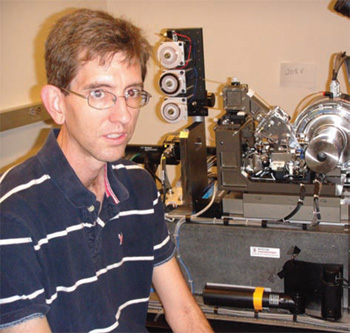I have always thought that one of the goals of ehealth was towards life extension, and this research article is indicative of the advances being made towards immortality, specifically - mind uploading - and a new word that I wonder might make head way in the English language lexicon - connectomics!
The strange neuroscience of immortality
July 30, 2012
[+]

Kenneth Hayworth with his Automatic Tape-collecting Lathe Ultramicrotome (ATLUM) device (credit: Kenneth Hayworth)
Neuroscientist Kenneth Hayworth believes that he can live forever, the Chronicle of Higher Education reports. But first he has to die.
“The human race is on a beeline to mind uploading: We will preserve a brain, slice it up, simulate it on a computer, and hook it up to a robot body,” he says.
He wants that brain to be his brain. He wants his 100 billion neurons and more than 100 trillion synapses to be encased in a block of transparent, amber-colored resin — before he dies of natural causes.
The connectome grand theory
To understand why Hayworth wants to plastinate his own brain you have to understand his field — connectomics, a new branch of neuroscience. A connectome is a complete map of a brain’s neural circuitry. Hayworth looks at the growth of connectomics — especially advances in brain preservation, tissue imaging, and computer simulations of neural networks — and sees a cure for death.
Among some connectomics scholars, there is a grand theory: We are our connectomes. Our unique selves — the way we think, act, feel — is etched into the wiring of our brains. Unlike genomes, which never change, connectomes are forever being molded and remolded by life experience.
A human connectome would be the most complicated map the world has ever seen. Yet it could be a reality before the end of the century, if not sooner, thanks to new technologies that “automate the process of seeing smaller,” as Sebastian Seung puts it in his new book, Connectome: How The Brain’s Wiring Makes Us Who We Are.
Hayworth looks at the growth of connectomics — especially advances in brain preservation, tissue imaging, and computer simulations of neural networks — and sees something else: a cure for death. In a new paper in the International Journal of Machine Consciousness, he argues that mind uploading is an “enormous engineering challenge” but one that can be accomplished without “radically new science and technologies.”
Hayworth has founded the Brain Preservation Foundation, which offer a cash prize for the first individual or team to preserve the connectome of a large mammal. A dependable brain-preservation protocol is possible within five years, Hayworth says. “We might have a whole mouse brain preserved very soon.”
The foundation has published a Brain Preservation Bill of Rights on its Web site. ”It is our individual unalienable right to choose death, or to choose the possibility of further life for our memories or identity, as desired,” the document declares.
Hayworth’s brain-preservation and mind-uploading protocol
Before becoming “very sick or very old,” he’ll opt for an “early ‘retirement’ to the future,” he writes. There will be a send-off party with friends and family, followed by a trip to the hospital. After Hayworth is placed under anesthesia, a cocktail of toxic chemicals will be perfused through his still-functioning vascular system, fixing every protein and lipid in his brain into place, preventing decay, and killing him instantly.
Then he will be injected with heavy-metal staining solutions to make his cell membranes visible under a microscope. All of the water will then be drained from his brain and spinal cord, replaced by pure plastic resin.
Every neuron and synapse in his central nervous system will be protected down to the nanometer level, Hayworth says, “the most perfectly preserved fossil imaginable.”
Using a ultramicrotome (like one developed by Hayworth, with a grant by the McKnight Endowment Fund for Neuroscience), his plastic-embedded preserved brain will eventually be cut into strips, and then imaged in an electron microscope. The physical brain will be destroyed, but in its place will be a precise map of his connectome.
In 100 years or so, Hayworth says, scientists will be able to determine the function of each neuron and synapse and build a computer simulation of the mind. And because the plastination process will have preserved his spinal nerves, the computer-generated mind can be connected to a robot body.
“This isn’t cryonics, where maybe you have a .001 percent chance of surviving,” he said. “We’ve got a good scientific case for brain preservation and mind uploading.”







